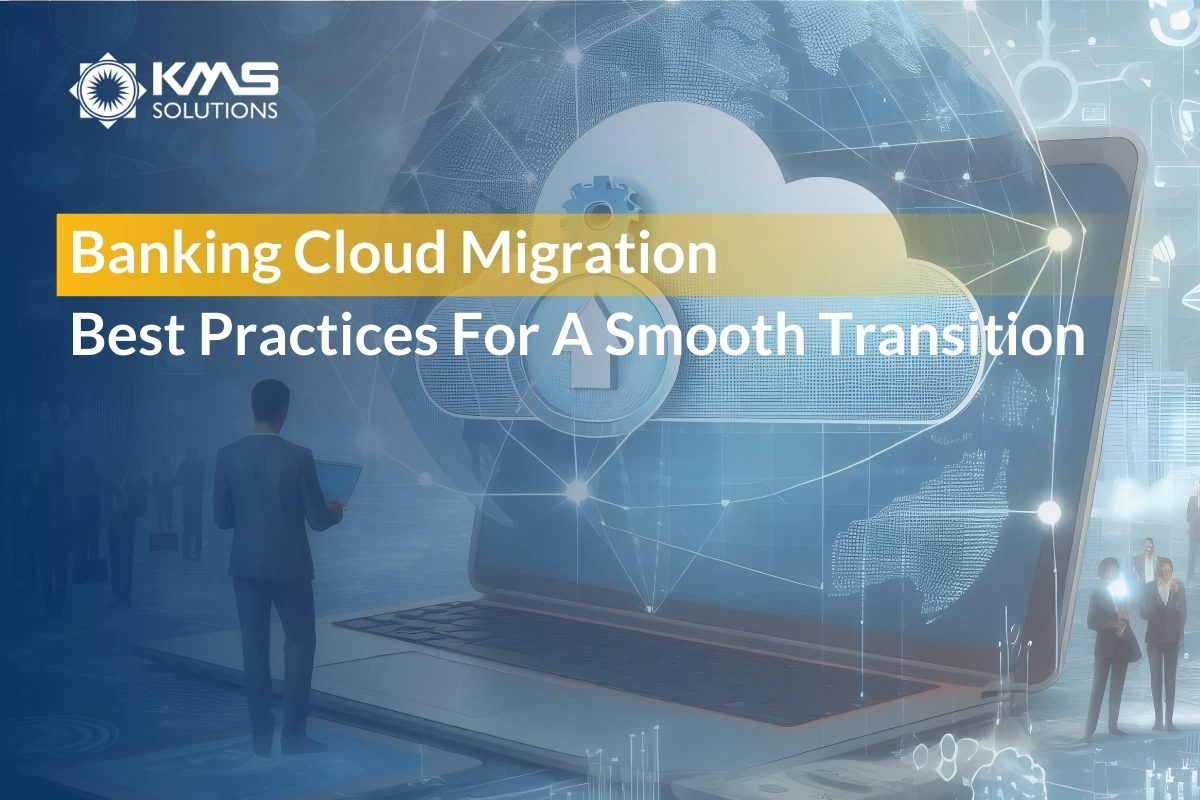In the ever-evolving banking sector, transitioning to the cloud has emerged as a crucial strategy for institutions seeking to boost their operational effectiveness and security. But the journey to the cloud is fraught with potential pitfalls. How can banks transition smoothly without compromising their core functions?
This article offers a comprehensive guide to best practices in banking cloud migration, from strategic planning to execution. Through innovative strategies and expert insights, we’ll guide you toward a successful cloud journey!
1. What is Banking Cloud Migration?

Banking cloud migration refers to the process of moving a bank’s digital operations, data, applications, and services from traditional on-premises infrastructure to cloud-based platforms. This transition aims to leverage the scalability, flexibility, and cost-effectiveness of cloud computing.
Read more: Banking Cloud Migration: Best Practices for a Smooth Transition
In general, it involves several key components, including data storage, core banking systems, customer relationship management (CRM), and financial transaction processing.
Read more: What is a Core Banking System? Essential Functions and Innovations
The trend towards cloud migration in banking has been accelerating in recent years. Key statistics of Neontri highlight the growing adoption and investment in cloud technologies within the banking sector:
- 90% of organizations in the financial sector are embracing cloud solutions to modernize their operations and improve service delivery.
- Global expenditure on cloud services is expected to surpass 1.12 trillion euros by 2025
- 64% of financial institutions have implemented or are planning to implement zero-trust security models in their cloud environments by the end of 2024.
Read more: What is a Core Banking System? Essential Functions and Innovations
2. Benefits of Banking Cloud Migration

Cloud migration is transforming the banking industry, offering a multitude of benefits. Below, we explore some key advantages from diverse perspectives
2.1 Cost Efficiency
Transitioning to the cloud fundamentally alters the financial landscape for banks. Traditional on-premises infrastructure demands significant capital expenditure for hardware, software, and ongoing maintenance. Conversely, cloud services function on a subscription or pay-as-you-go model, reducing initial expenses and enabling financial institutions to pay solely for the resources they utilize.
Furthermore, cloud providers frequently offer competitive pricing models and the ability to dynamically adjust resources based on real-time needs.
2.2 Enhanced Security
Secondly, security is always a concern in the banking sector. Cloud service providers excel in offering advanced security solutions that may surpass in-house capabilities.
Major cloud providers invest heavily in cutting-edge security technologies, including encryption, multi-factor authentication, and constant threat monitoring. They adhere to the latest compliance standards and undergo regular security audits, ensuring that the banks’ data is protected by the most up-to-date measures.
2.3 Improved Customer Experience
Cloud platforms enable banks to analyze vast amounts of customer data swiftly, providing insights that drive personalized banking experiences. Moreover, personalizing products and services to fit each customer’s needs increases satisfaction and loyalty.
Additionally, the cloud’s capacity for real-time processing ensures that transactions and customer interactions are efficient and responsive. The integration of emerging technologies like artificial intelligence and machine learning into cloud environments allows banks to bring innovative services.
2.4 Scalability and Flexibility
The dynamic nature of the banking industry demands a high degree of scalability and flexibility. Cloud computing offers unparalleled scalability, enabling banks to quickly adjust their resources in response to changing market conditions and customer demands. Whether it’s handling a surge in transaction volume during peak times or scaling down during quieter periods, the cloud provides the agility needed to adapt seamlessly.
3. Challenges in Banking Cloud Migration
Cloud migration offers banks a promising opportunity to enhance their operational efficiency, but it also brings significant challenges. Addressing them requires careful planning, robust security measures, effective cost management, and a clear understanding of regulatory requirements.
- Data Security and Compliance: According to a 2023 report by Deloitte, 47% of financial services firms cited security and privacy concerns as the top barrier to cloud adoption. Moreover, banks handle sensitive information, including personal and financial data, which must be protected from breaches and unauthorized access.
Therefore, banking institutions must adhere to strict regulatory standards, including the GDPR, PCI DSS, and many more. However, complying with these regulations in a cloud setting can be intricate.
- Data Migration Complexity: Migrating large volumes of data from legacy systems to cloud platforms is often risky. Addressing this challenge means focusing on data integrity, minimizing downtime, and ensuring consistency throughout the migration process.
Read more: Essential Strategies for Banking Data Migration in 2024
- Cost Management: While cloud migration can offer cost savings in the long run, managing and predicting cloud costs can be challenging. Unexpected expenses, such as those related to overprovisioned resources or data transfer fees, can impact budgets.
- Training or reskilling employees: Organizing IT operations in the cloud differs from on-premises environments, simplifying models like DevOps and automation. Banks must hire or retrain employees for cloud-specific functions, allowing time for training and certifications during migration.
Read more: Simplified Migration, Minimal Downtime
4. Process for Banking Cloud Migration
Migrating banking systems to the cloud is a strategic move. To realize these benefits, it’s essential to follow best practices that ensure a smooth, secure, and compliant transition. Below are the key steps and considerations for a successful banking cloud migration.
4.1 Planning and Assessment

Successful migration relies on thorough planning and assessment. This phase helps in understanding the current IT landscape and identifying potential challenges and opportunities.
Key steps:
- Use tools and frameworks for a detailed assessment of your IT environment.
- Organize meetings with stakeholders to gather insights and address concerns.
- Develop a detailed project plan outlining the scope, timeline, and resources required for the migration.
4.2 Choosing the Right Cloud Service Provider

Next, selecting the right cloud service provider (CSP) is for leveraging the cloud’s full potential while ensuring security and compliance.
Key steps:
- Create a checklist of your requirements and evaluate potential CSPs against this list.
- Conduct pilot projects or proofs of concept to test the CSP’s capabilities.
- Review customer testimonials and case studies to gauge the CSP’s performance and reliability.
4.3 Developing a Migration Roadmap

A well-defined migration roadmap provides a structured and systematic approach to the transition. It outlines the steps, timelines, and resources needed for each phase of the migration, helping to keep the project on track.
A detailed roadmap also helps in setting realistic expectations and aligning the migration with the bank’s strategic goals.
Key steps:
- Develop a detailed migration plan outlining each phase, key activities, and timelines.
- Establish a project management office (PMO) to oversee the migration and ensure alignment with the roadmap.
- Regularly review progress against the set milestones and KPIs, making adjustments as necessary.
4.4 Ensuring Data Security and Compliance

Ensuring these aspects during migration helps to safeguard customer data, maintain trust, and avoid legal penalties. A lapse in security or compliance can result in severe financial and reputational damage. Furthermore, robust security measures and compliance protocols enhance the overall resilience of the bank’s IT infrastructure, making it better equipped to handle potential threats.
Key steps:
- Work with your CSP to implement robust security measures and configure security settings appropriately.
- Establish a compliance team to oversee regulatory requirements and conduct regular audits.
- Use third-party tools and services for continuous monitoring and threat detection.
4.5 Conducting pre-migration testing

Pre-migration testing is essential for identifying potential issues before they impact the live environment. This phase helps to ensure that applications and data will function correctly after the migration, minimizing the risk of downtime and disruptions.
Thorough testing allows for the detection and resolution of compatibility issues, performance bottlenecks, and other technical challenges.
Key steps:
- Set up a staging environment that mirrors your production environment for testing purposes.
- Develop test cases and scenarios that cover all aspects of the migration.
- Collect and analyze feedback from end users, making necessary adjustments before the final migration.
6. Future Trends in Banking Cloud Migration
The future of banking cloud migration is poised to transform the financial services industry, bringing forth numerous innovations and strategic advantages.
- Hybrid Cloud Adoption: Banks are increasingly moving towards hybrid cloud solutions that combine private and public cloud environments. By adopting hybrid cloud models, banks can ensure regulatory compliance and data security while achieving greater operational flexibility.
- API-First Strategies: Application Programming Interfaces (APIs) are becoming the backbone of modern banking. Future trends will see banks adopting API-first strategies to enable seamless integration with third-party services, fintech startups, and other financial institutions.
- Sustainability and Green Cloud: Environmental sustainability is becoming increasingly important for banks and their stakeholders. Green cloud solutions, with banks adopting energy-efficient data centers, optimizing resource usage, and leveraging renewable energy sources will be greatly focused.
Therefore, to stay on top of the trend, businesses need to have consultants and experts to provide the latest insights into banking cloud migration. KMS Solutions is one such partner, offering a range of services tailored to the needs of financial institutions undergoing cloud transformation.
Understanding that each bank has unique needs, KMS Solutions offers customized migration strategies that align with specific business goals. And beyond the initial migration, KMS Solutions provides ongoing support to ensure that banks continue to benefit from their cloud investments. This includes continuous monitoring, performance optimization, and the implementation of new innovations as they emerge.









